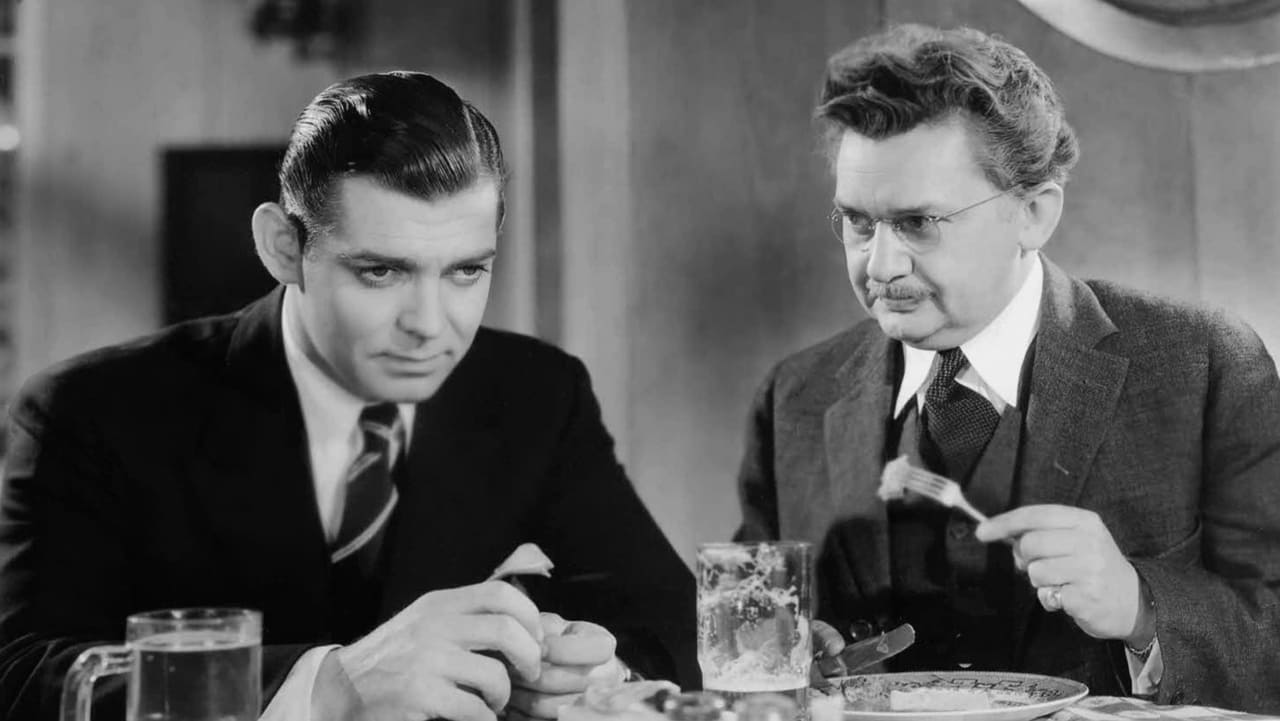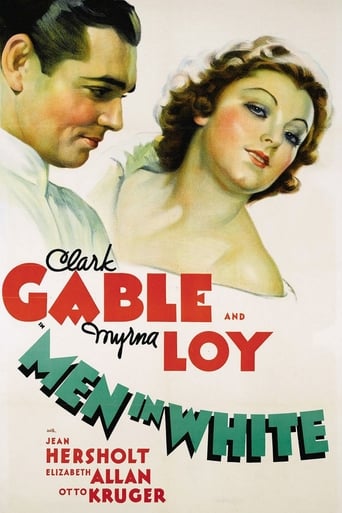

Interesting sets, blending high tech and art deco with an almost expressionist feel, are the highlight of 'Men in White'. Director Ryszard Boleslawski also uses shadows and some interesting framing to create a film that is often beautiful to watch.It's also interesting to see Clark Gable in the role of an up and coming doctor who finds himself pulled between his personal life (a fiancé, played by Myrna Loy) and his professional life (the desire to someday work for a renowned doctor, played by Jean Hersholt). The film spends quite a bit of time establishing the fact that he takes the job seriously, cares for his patients, and that the job requires a lot of sacrifice. Therein lies its main problem - it's more than a little heavy-handed in its "job or career" theme. It's based on a Pulitzer Prize winning play, but almost as if it were written as propaganda by someone in the medical field. When Myrna Loy dramatically proclaims "It's bigger than any of us...humanity" as she contemplates the importance of being a doctor, I laughed out loud, and not in a good way. I've seen Myrna in a lot of films, and that moment is the worst I've ever seen for her. It's not all bad, and the best line in the script is when Hersholt puts things in perspective, saying that doctors are still groping around with respect to their knowledge of the human body, but they're doing so more intelligently than twenty years ago, and in twenty more years their understanding will be better still. A very interesting part of the plot is when a young nurse (Elizabeth Allan) suddenly needs an operation herself - and we realize, without it being explicitly mentioned, that she attempted an abortion on her own. The restraint heightens the shock and drama, and I couldn't help but wonder how many women this happened to prior to abortion being legal. The Catholic Legion of Decency didn't want viewers to think about that, and put the film on their no-watch list. Unfortunately, it's handled melodramatically, including Loy ludicrously appearing in the operating room. The film appears to have just made it in just before the Hays Code was enforced, but the fact that it was looming also appears to have affected the story line in the adaptation of the play, which is unfortunate. There are some moments of levity in an otherwise heavy film. Young interns pursue women, scamper about in towels, and quip things like "That's the trouble with being in love - it kills your sex life!" I smirked as several times a characters says someone else needs a spanking when they're not cooperating, e.g. Loy to her father, the doctor to Loy, etc. Perhaps the funniest inappropriate line was from the lab technician, who raves in the presence of a man grieving over his wife's cancer, "Say, George, you know that Simpson gal down in X-ray? She was over at Fleischer's, table next to mine. Oh, she's luscious. Had on one of those dark tight silk things. Does she dress close to the skin. Boy, what a chassis. What a chassis."It's interesting to see "state of the art" medicine in 1934, the sets are very nice, and the film deserves a look for its star power and the reference to abortion. Just guard your expectations, as the plot is not very well developed, and the script is preachy.
... View MoreMarvelous film dealing with the medical profession and its effects on those who serve it along with their loved ones.Clark Gable is great as the terrific doctor with a future, ready to cast much of it aside for love of the wealthy snob played wonderfully by Myrna Loy. Dr. Gable stands up to a head doctor in treating a patient, a young girl, he later saves.In the year before she tackled the role of Lucie Manette in the memorable "A Tale of 2 Cities," Elizabeth Allan is superb in the supporting role of a nurse who loved Gable, before tragedy strikes.Gene Hershholt is memorable as Dr. Hochberg, the 1930s answer to Raymond Massey in the Dr. Kildare series on television in the 1960s.This is a story of dedication, ethics, and those committed to medicine, no matter the cost.
... View MoreThis movie is best known in film history as the inspiration for the Three Stooges' comedy short "Men in Black", although there is really no comparison between the two. This is a well-paced little hospital drama made right before the production code began to be enforced. Dr. George Forrest (Clark Gable) is an intern at a busy hospital and Laura Hudson (Myrna Loy) is his socialite fiancée. Forrest wants to study under Dr. Hochberg (Jean Hersholt) when his time is up as an intern, but it means only twenty dollars a week and long indefinite hours. Laura wants her fiancée to go into private practice so that they can have a normal life together after their marriage. Laura may be a bit of a spoiled brat, but she knows it, so it makes her more likable. Forrest is torn between wanting to please Laura and wanting the great chance to work with Hochberg. A fight between the couple one night sets up the scene for a scandal that has the opportunity to derail both Forrest's career and personal life. That is pretty much the crux of the movie.What keeps it interesting is the pacing and the performances. I found it to be the most believable of the Gable/Loy pairings I've seen. Plus, unlike so many MGM dramas of the 30's, there is no unreasonable bad guy in sight - only the fight to advance medicine. Another matter of interest is the art deco interior design of the hospital. For example, there is a staircase in the main lobby of the hospital that is out of this world.
... View MoreTwo things are surprising about this film: Clark Gable could really act and Richard Boleslawski knew what to do with a camera. There's a muted fantasy aspect about this film, and there are cinematic statements, made through symbols, that remind one of "Citizen Kane". "Men in White" is a filmed play, done so convincingly that even a cynical viewer can be persuaded to judge the medical profession as one of honor. Richard Boleslawski has been greatly overlooked as a stylist, and Gable as a real actor, before he became crusted over. There's a scene, where he rips a hypodermic needle from the hands of an incompetent doctor, that really works well.
... View More